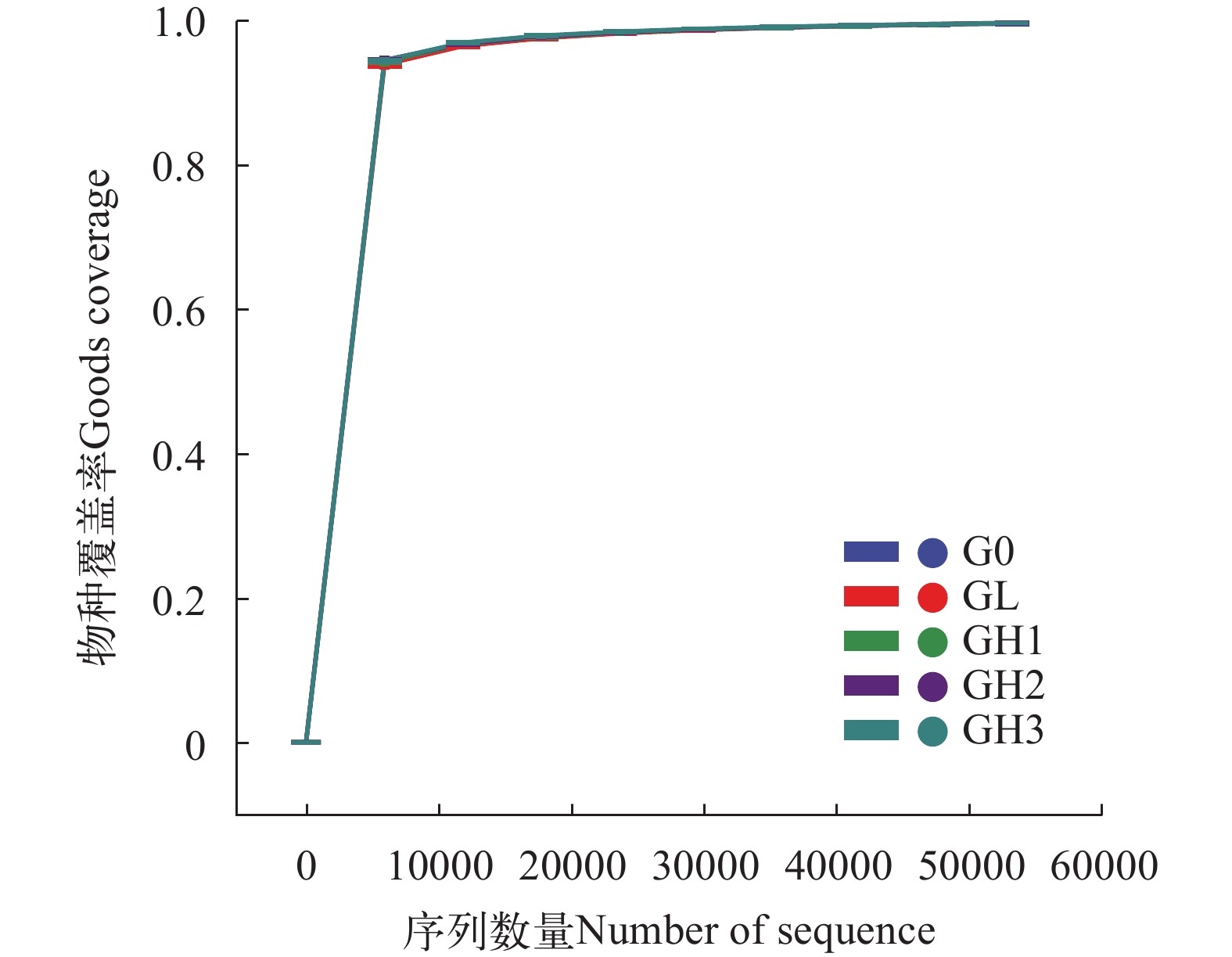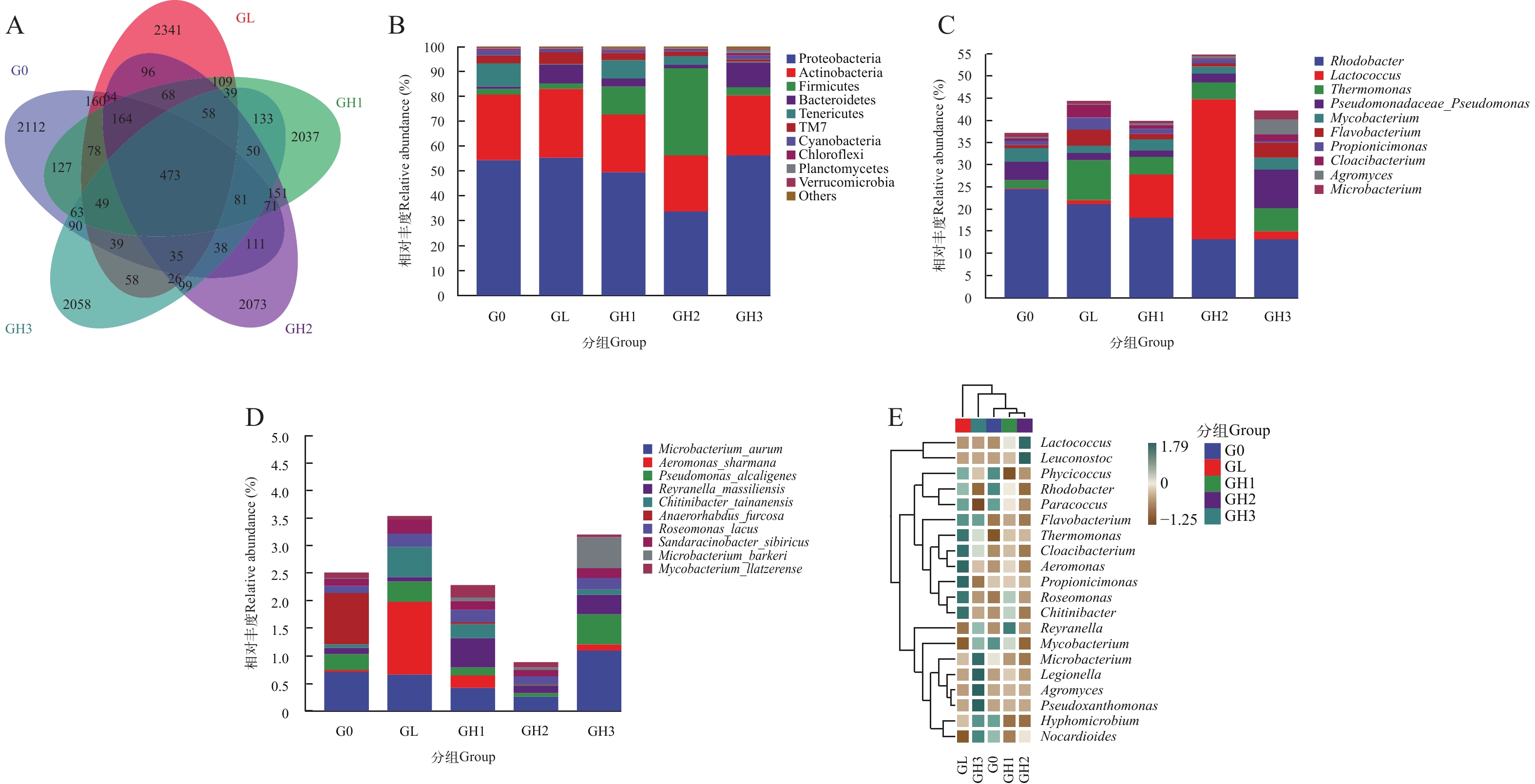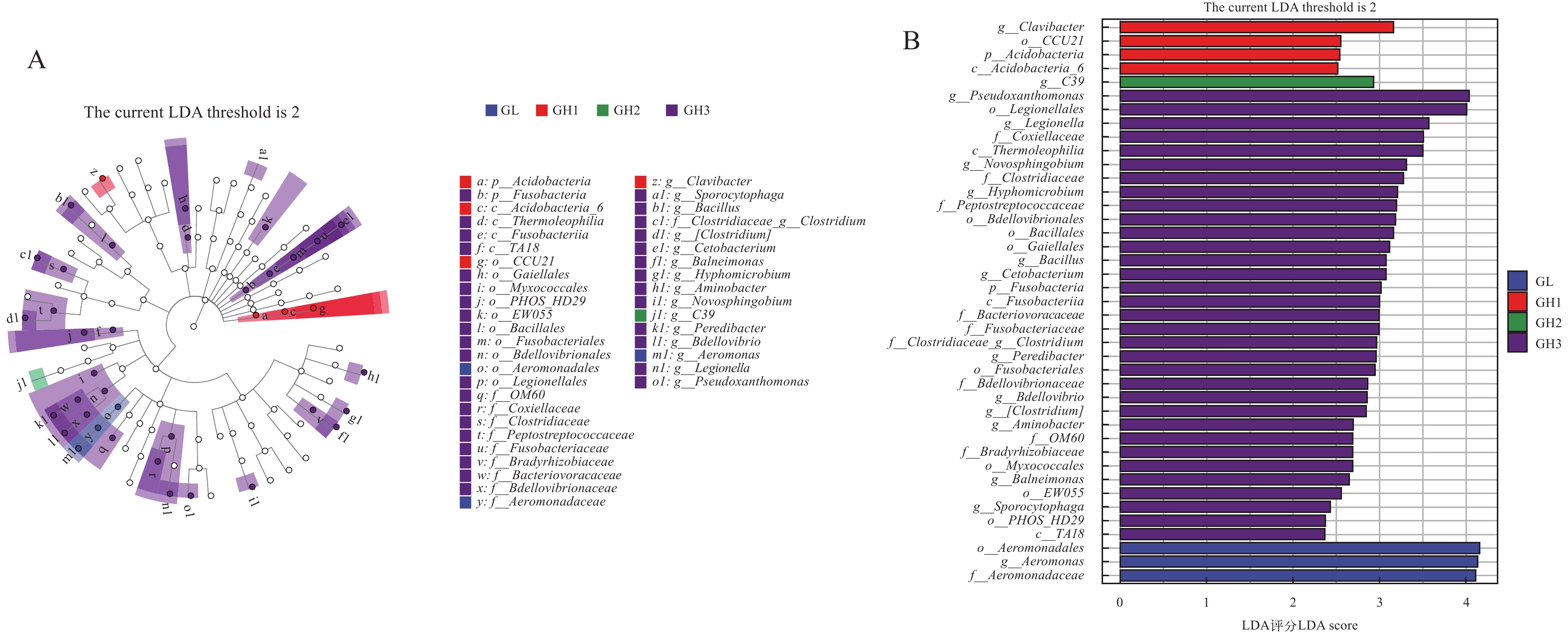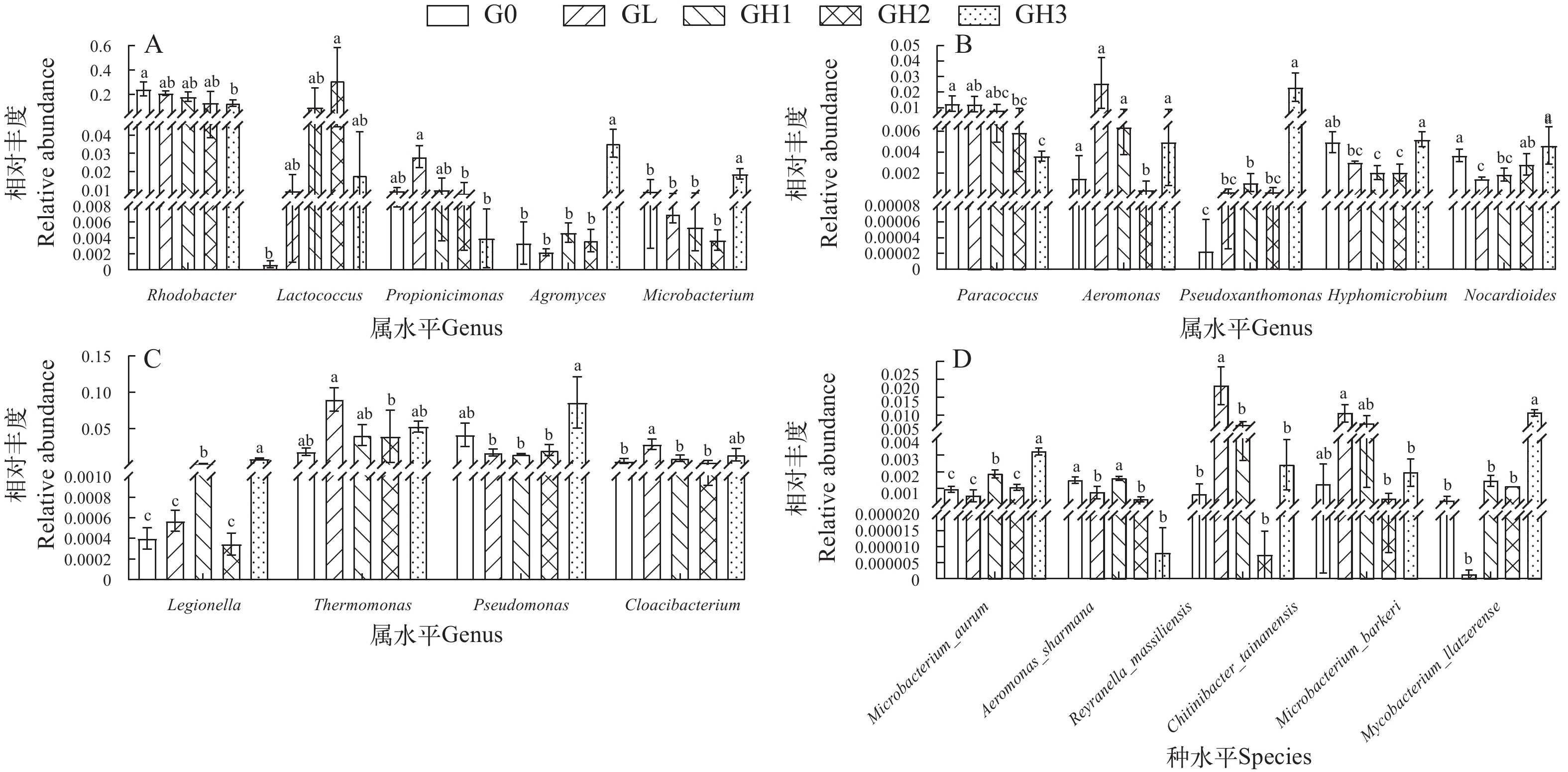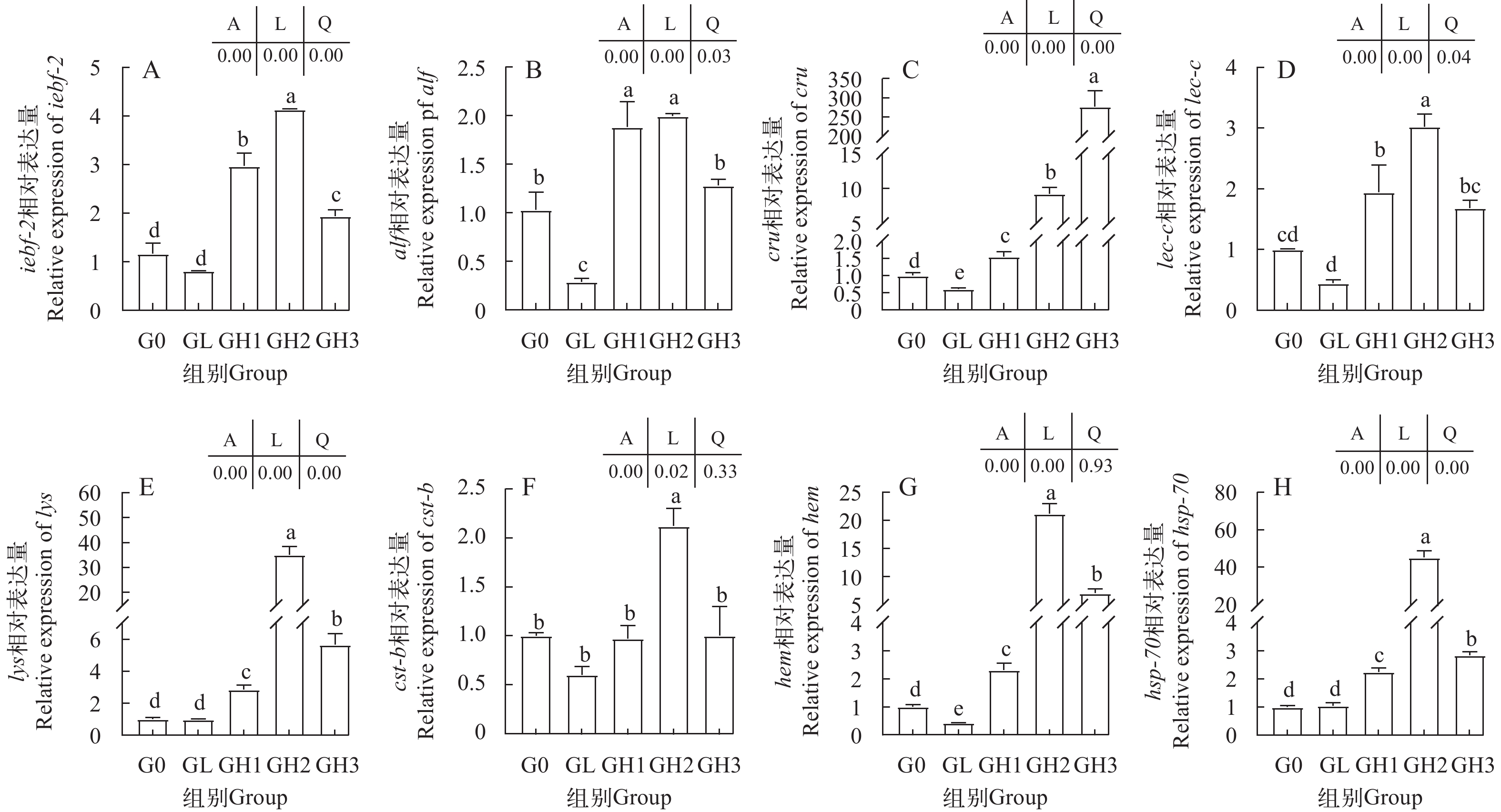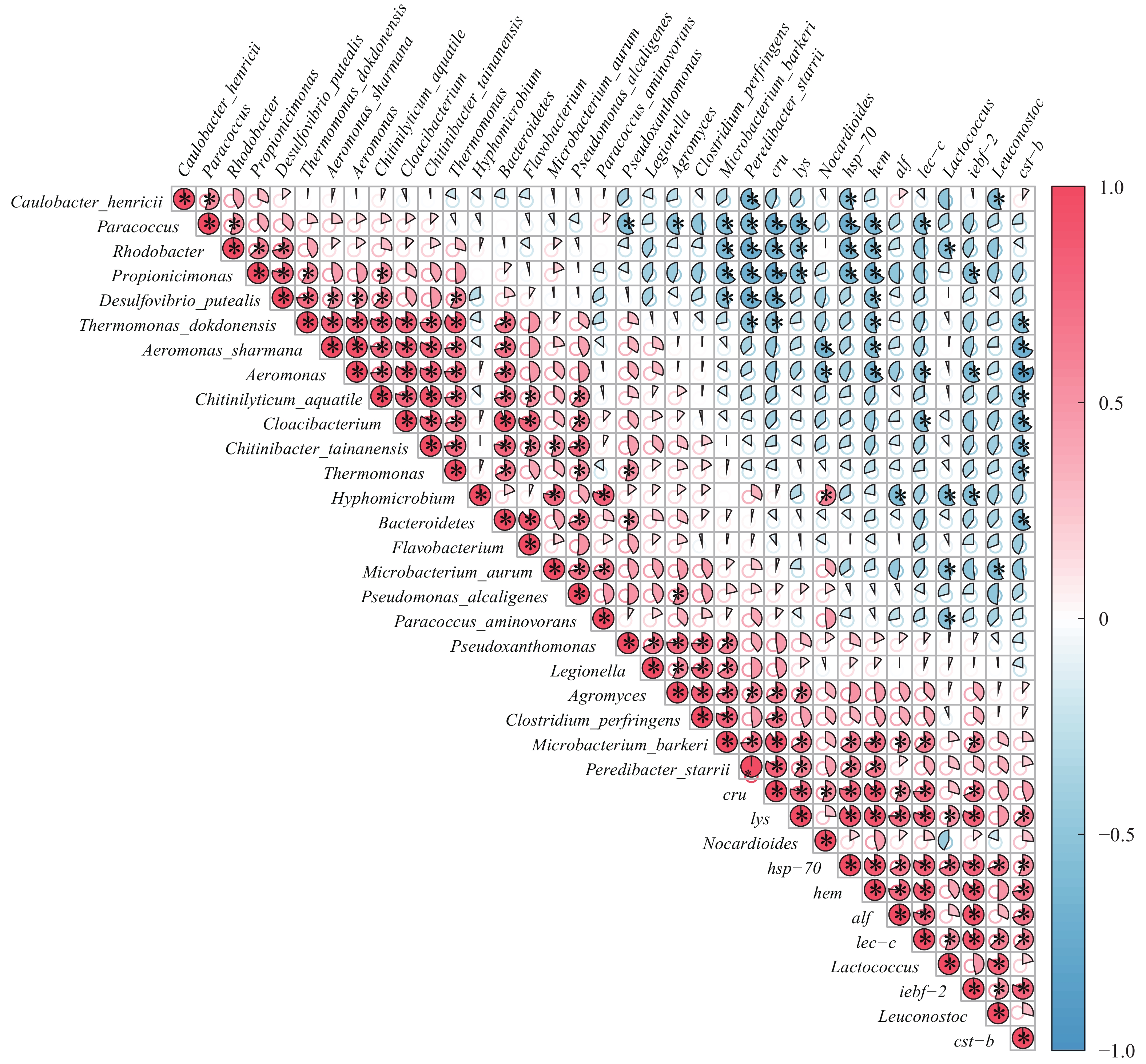GLYCININ ON INTESTINAL MICROBIOTA AND ANTIMICROBIAL RELATED GENES IN RED SWAMP CRAYFISH (PROCAMBARUS CLARKII)
-
摘要:
实验旨在探究不同水平的大豆球蛋白对克氏原螯虾(Procambarus clarkii)肠道菌群和抗菌相关基因的影响。在饲料中添加0 (G0组, 作为对照组)、1.82% (GL组)、3.64% (GH1组)、5.46% (GH2组)和7.28% (GH3组)五种不同水平的大豆球蛋白饲喂克氏原螯虾(平均体重约为4.3 g) 4周。养殖实验结束后测定肠道微生物的组成和抗菌相关基因的表达。结果显示: (1)饲料中的大豆球蛋白对克氏原螯虾肠道菌群的Alpha多样性没有显著性影响, 但改变了其肠道菌群组成。GL组Cloacibacterium、沙曼气单胞菌(Aeromonas sharmana)等菌群的相对丰度显著高于其他4组。与G0组相比, 红杆菌属(Rhodobacter)、副球菌属(Paracoccus)、丙酸杆菌属(Propionicimonas)和生丝微菌属(Hyphomicrobium)等益生菌及亨氏柄杆菌(Caulobacter henricii)的相对丰度在GH2或GH3组中显著下降; 而GH3组壤霉菌属(Agromyces)、巴氏微杆菌(Microbacterium barkeri)、假黄色单胞菌属(Pseudoxanthomonas)和军团杆菌属(Legionella)等潜在病原菌的相对丰度显著高于G0组。(2)随着大豆球蛋白水平的升高, 各组肠道抗菌相关基因的表达水平呈现一次线性和二次响应的变化趋势。与G0组相比, GL组抗脂多糖因子(alf)、甲壳素(cru)和血蓝蛋白(hem)基因的表达水平显著下降; 除组织蛋白酶-B (cst-b)外, GH1、GH2和GH3组其他抗菌相关基因的表达水平随着饲料中大豆球蛋白水平的升高而显著上升; GH2组cst-b的表达水平显著高于其余4组。(3)斯皮尔曼相关分析结果表明肠道菌群和抗菌相关基因之间存在显著的相关关系。cru、alf、C型凝集素(lec-c)、溶菌酶(lys)、白细胞介素增强因子结合子-2 (iebf-2)、hem、热休克蛋白-70 (hsp-70)和cst-b的表达水平与亨氏柄杆菌、副球菌属、红杆菌属、丙酸杆菌属、Desulfovibrio putealis、Thermomonas dokdonensis、沙曼气单胞菌和气单胞菌属、Chitinilyticum aquatile、台湾几丁质杆菌、Cloacibacterium和生丝微菌属等菌群的相对丰度具有显著的负相关关系; 而与壤霉菌属、产气荚膜梭杆菌(Clostridium Perfringens)、巴氏微杆菌、乳球菌(Lactococcus)、明串珠菌属(Leuconostoc)、类诺卡氏菌属(Nocardioides)和Peredibacter starrii等菌群的相对丰度具有显著的正相关关系。综上所述, 饲料中低水平的大豆球蛋白(1.82%)在一定程度上能够促进肠道中益生菌的生长, 改善肠道菌群健康, 同时下调抗菌相关基因的表达; 而高水平的大豆球蛋白(≥3.64%)可能抑制了益生菌的生长, 导致病原菌的增殖, 从而破坏了肠道菌群稳态, 并且上调了抗菌相关基因的表达。相关分析结果表明抗菌相关基因与肠道菌群之间可能存在一定的互作关系。
Abstract:Glycinin found in soybean meal has been identified as an antinutrient factor, capable of impeding the growth and health of aquatic animals. However, limited research exists regarding the impact of glycinin on the intestinal microbiota and antimicrobial related genes in red swamp crayfish (Procambarus clarkii). This study aimed to investigate the effects of five different glycinin levels on intestinal microbiota and antimicrobial related genes of crayfish. Crayfish with an average body weight of approximately 4.3 g subjected to diets containing five graded levels of glycinin (0, 1.82%, 3.64%, 5.46%, and 7.28%) over a period of 4 weeks. The groups were designated based on the level of dietary glycinin as follows: G0 (control group), GL, GH1, GH2, and GH3 group, respectively. Following the feeding trial, alterations and distinctions in the expression of intestinal microbiota and selected genes were evaluated. 16S rRNA gene sequencing showed no significant difference in alpha diversity among the groups. However, the beta diversity was affected by different levels of dietary glycinin, indicating a shift in the composition of intestinal microbiota. Relative abundance analysis demonstrated a significant increase in Aeromonas sharmana and Cloacibacterium in the GL group compared to other groups. Conversely, Rhodobacter, Paracoccus, Propionicimonas, Hyphomicrobium, and Caulobacter henricii exhibited a significant decrease in abundance of GH2 or GH3 groups compared to the G0 group. Additionally, Agromyce, Microbacterium barkeri, Pseudoxanthomonas, and Legionella were significantly enriched in the GH3 group. In addition, the expression of antimicrobial related genes displayed a complex trend of linear and quadratic responses with increasing levels of dietary glycinin. Initially, all selected genes were down-regulated, followed by up-regulation, and finally down-regulation. Specifically, compared to G0 group, the GL group showed a significant decrease in the expression of alf, cru, and hem. However, with increasing levels of dietary glycinin, the expression of iebf-2, hsp-70, alf, cru and hem, lec-c, and lys in GH1, GH2, and GH3 groups significantly increased. Additionally, the expression of cst-b was significantly enhanced in GH2 group compared to other groups. Spearman correlation analysis demonstrated a significant correlation between the intestinal microbiota and antibacterial related genes. The relative expression levels of iebf-2, hsp-70, alf, cru, hem, lec-c, lys, and cst-b were significantly negatively correlated with the relative abundance of Caulobacter henricii, Paracoccus, Rhodobacter, Propionicimonas, Desulfovibrio putealis, Thermomonas dokdonensis, Aeromonas sharmana, Aeromonas, Chitinilyticum aquatile, Chitinilyticum tainanensis, Cloacibacterium, and Hyphomicrobium, while significantly positively correlated with the relative abundance of Agromyces, Clostridium Perfringens, Microbacterium barkeri, Lactococcus, Leuconostoc, Nocardiodes, and Peredibacter starri. In conclusion, to a certain extent, a low level of glycinin in diet (1.82%) could promote the growth of intestinal probiotics and enhance the health of intestinal microbiota, accompanied by down-regulation of antimicrobial related genes. However, high levels of dietary glycinin (≥3.64%) could inhibit the growth of probiotics while promoting the reproduction of pathogenic bacteria in the intestine, thereby destroying the homeostasis of intestinal microbiota and up-regulating the expression of antimicrobial related genes. The results of correlation analysis suggest potential interactions between antibacterial related genes and intestinal microbiota.
-
近年来, 在饲料中过量使用豆粕可引起水产养殖动物的肠道炎症, 称为豆粕型肠炎。豆粕型肠炎与豆粕中的抗营养因子密切相关[1—5]。大豆球蛋白是豆粕中最主要的抗原蛋白之一, 约占大豆总蛋白含量的40%, 目前通过高压、加热、酶解或者微生物发酵等方法均不能有效降解, 且低成本、可产业化的处理方法仍不成熟[6]。目前研究已证实: 4%以上的大豆球蛋白可阻碍包括但不限于杂交黄颡鱼(Pelteobagrus fulvidraco ♀ × Pelteobaggrus vachelli ♂)[7]、洛氏鱥(Rhynchocypris lagowskii Dybowski)[8]、草鱼(Ctenopharyngodon idella)[9]、中华绒螯蟹(Eriocheir sinensis)[10]、杂交石斑鱼(Epinephleus lanceolatus ♂ × E. fuscoguttatus ♀)[11]、黄金鲫(Carassius auratus×Cyprinus carpio)[12]、建鲤(Cyprinus carpio var Jian)[13]等水产养殖动物的生长, 诱发食源性肠道炎症。而5%的大豆球蛋白对罗氏沼虾(Macrobrachium rosenbergii)的生长和健康无显著影响[14]。在大菱鲆(Scophthalmus maximus L.)的相关研究中, 12%的大豆球蛋白才引起肠道白细胞浸润略有增加和肠道菌群改变[15]。2%和4.5%的大豆球蛋白可分别促进杂交石斑鱼和斜带石斑鱼(Epinephelus coioides)的生长性能[11, 16]。以上研究结果表明大豆球蛋白对水产养殖动物的影响具有物种特异性, 且与其水平和存在形式息息相关。
肠道微生物具有调节机体生长发育、新陈代谢、免疫反应等多种生物功能, 维持肠道微生物的稳态有利于促进水产养殖动物的肠道健康[17]。大豆球蛋白引起的食源性肠道炎症的病理特征之一主要是肠道微生物菌群的紊乱[10, 18]。据报道, 4%—16%的大豆球蛋白可导致斜带石斑鱼、中华绒螯蟹、珍珠龙胆石斑鱼(Epinephelus fuscoguttatus♀×E. lanceolatus♂)及大菱鲆肠道中无色杆菌属(Achromobacter)、弧菌属(Vibrio)、气单胞菌属(Aeromonas)、假黄色单胞菌属(Pseudoxanthomonas)及发光杆菌属(Photobacterium)等潜在致病菌群的相对丰度增加[15, 16, 19, 20]。而目前关于大豆球蛋白对克氏原螯虾肠道菌群的影响还尚未被报道。此外, 大多数研究聚焦在肠道微生物对宿主的影响方面, 而关于宿主与微生物群之间的相互作用——即宿主如何调节肠道微生物群的相关研究却较少[17]。宿主可通过免疫成分和非免疫因素来调节和重塑肠道微生物群, 维持肠道微生物群落的稳态。研究结果证明: Th17细胞产生的一种标志性炎症细胞因子il-17A/F1可调节和维持日本青鳉(Oryzias latipes)的肠道菌群健康[21]。在甲壳动物中, 抗脂多糖因子(Anti-liposaccharides factor, alf)、甲壳素(Crustin, cru)和溶菌酶(Lysozyme, lys)等相关基因可产生一定的抗菌肽来调节肠道菌群[22]。此外, C型凝集素(Lectin-c, lec-c)[23]、白细胞介素增强因子结合子2 (Interleukin enhancer binding factor 2, iebf-2)[24]、组织蛋白酶B (Cathepsin B, cst-b)[25]、血蓝蛋白(Hemocyanin, hem)[26]和热休克蛋白-70 (Heat shock protein, hsp-70)[27]等非特异性免疫因子也被证实参与了抗菌反应。而大豆球蛋白对这些抗菌相关基因的影响及这些抗菌相关基因与肠道菌群的互作机制尚待深入研究。
克氏原螯虾(Procambarus clarkii)肉质鲜美、营养丰富, 深受我国消费者青睐。近年来, 使用豆粕等优质植物蛋白源替代鱼粉来降低饲料成本是克氏原螯虾养殖产业的研究热点之一[28]。使用豆粕与菜粕作为植物蛋白源(质量比为1﹕1)替代33.8%的鱼粉时可促进克氏原螯虾的生长和繁殖性能, 然而超过86.7%则会抑制其生长[29]。此外, 豆粕替代鱼粉的比例不断升高也导致了淡水小龙虾(Astacus leptodactylus)的生长迟缓[30]。在克氏原螯虾商业饲料中, 鱼粉比例较低, 而豆粕比例较高, 可能会对其生长和健康造成不利影响[31]。豆粕对克氏原螯虾生长和健康的不良影响可能由豆粕中大豆抗原蛋白和大豆皂甙等抗营养因子引起[32—36]。因此, 本试验在克氏原螯虾饲料中添加不同水平的大豆球蛋白, 通过分析大豆球蛋白对克氏原螯虾肠道菌群组成的影响, 对今后大豆蛋白源在克氏原螯虾饲料中的研发与应用具有实用价值和重要意义。此外, 还探究了大豆球蛋白对克氏原螯虾肠道抗菌相关基因表达水平的影响。并初步探索克氏原螯虾肠道菌群与抗菌相关基因之间的相关关系, 从而丰富宿主和肠道微生物之间相互作用的理论研究, 为今后克氏原螯虾肠道健康的研究提供理论参考。
1. 材料与方法
1.1 试验饲料
克氏原螯虾试验饲料中添加的大豆球蛋白遵循本实验室已发表的试验方法获得, 分离得到的大豆球蛋白纯度达到85%以上[7]。以鱼粉、鸡肉粉、玉米蛋白粉为蛋白来源, 高筋面粉为碳水化合物来源, 豆油作为脂肪来源制备试验饲料。试验饲料分别添加了0、1.82%、3.64%、5.46%和7.28%五种不同水平的大豆球蛋白, 分别相当于豆粕替代了0、25%、50%、75%和100%的鱼粉, 并依次命名为G0、GL、GH1、GH2和GH3。采用植物大豆球蛋白(Glycinin)ELISA检测试剂盒(晶美生物科技有限公司, 盐城)测定各组大豆球蛋白免疫活性分别为0、1.47%、3.02%、5.00%和6.67%。将所有原料完全粉碎, 过60目筛。之后, 将所有配料粉严格按照逐级预混原则混合均匀, 加入豆油手工搓匀, 最后加入适量蒸馏水彻底混匀。通过饲料机(霍巴特混合机, A200)压制成2 mm的颗粒饲料, 45℃烘干至恒重, 于–20℃中保存待用。实验饲料配方见表 1。
表 1 饲料配方及营养组成(%干物质)Table 1. Formulation and nutritional composition of experimental diets (% dry matter)成分Ingredient 组别Group G0 GL GH1 GH2 GH3 白鱼粉White fishmeal 28.00 21.00 14.00 7.00 0.00 鸡肉粉Chicken powder 12.00 12.00 12.00 12.00 12.00 玉米蛋白粉Corn gluten flour 10.00 10.00 10.00 10.00 10.00 大豆球蛋白Glycinin 0.00 1.82 3.64 5.46 7.28 酪蛋白Casein 0.00 2.40 4.80 7.20 9.60 豆油Soybean oil 2.80 3.35 3.90 4.45 5.00 高筋面粉High gluten flour 34.20 36.43 38.66 40.89 43.12 氯化胆碱Choline chloride 1.00 1.00 1.00 1.00 1.00 维生素预混物Vitamin premix1 2.00 2.00 2.00 2.00 2.00 矿物质预混物Mineral premix2 2.00 2.00 2.00 2.00 2.00 氯化钠NaCl 1.00 1.00 1.00 1.00 1.00 磷酸二氢钙Ca(H2PO4)2 2.00 2.00 2.00 2.00 2.00 抗氧化剂Antioxidant 1.00 1.00 1.00 1.00 1.00 防霉剂Anti-mildew agent 0.50 0.50 0.50 0.50 0.50 海藻酸钠Sodium alginate 2.00 2.00 2.00 2.00 2.00 甜菜碱Betaine 1.00 1.00 1.00 1.00 1.00 三氧化二铬Cr2O3 0.50 0.50 0.50 0.50 0.50 营养组成Nutritional composition 粗蛋白Crude protein 35.72 35.67 35.66 35.97 35.18 粗脂肪Crude lipid 7.82 7.34 7.75 7.91 8.01 粗灰分Crude ash 8.83 8.75 8.85 8.45 8.29 注: 1维生素预混料(mg/kg): 维生素A, 1.67; 维生素D, 0.027; 维生素E, 50.20; 维生素K, 11.10; 维生素C, 100.50; 叶酸, 5.20; 泛酸钙, 50.20; 肌醇, 100.50; 烟酸, 100.50; 生物素, 0.12; 硫胺素, 20.50; 核黄素, 20.50; 维生素B6, 20.50; 维生素B12, 0.02; 纤维素, 645.25; 2矿物盐预混料(mg/kg): 氯化钠, 500.15; 七水合硫酸镁, 8155.55; 二水合磷酸二氢钠, 12500.51; 磷酸二氢钾, 16000.51; 一水合磷酸二氢钙, 7650.50; 七水合硫酸亚铁, 2286.15; 五水合乳酸钙, 1750.12; 七水合硫酸锌, 178.12; 一水合硫酸锰, 61.35; 五水合硫酸铜, 15.45; 七水合硫酸钴, 0.89; 碘化钾, 1.50; 亚硒酸钠, 0.59Note: 1The Vitamin premix (mg/kg): Vitamin A, 1.67; Vitamin D, 0.027; Vitamin E, 50.20; Vitamin K, 11.10; Vitamin C, 100.50; Folic acid, 5.20; Calcium pantothenate, 50.20; Inositol, 100.50; Niacin, 100.50; Biotin, 0.12; Thiamine, 20.50; Riboflavin, 20.50; Vitamin B6, 20.50; Vitamin B12, 0.02; Cellulose, 645.25; 2The Mineral premix (mg/kg): NaCl, 500.15; MgSO4·7H2O, 8155.55; NaH2PO4·2H2O, 12500.51; KH2PO4, 16000.51; Ca(H2PO4)2·H2O, 7650.50; FeSO4·7H2O, 2286.15; C6H10CaO6·5H2O, 1750.12; ZnSO4·7H2O, 178.12; MnSO4·H2O, 61.35; CuSO4·5H2O, 15.45; CoSO4·7H2O, 0.89; KI, 1.50; Na2SeO3, 0.59 1.2 养殖实验
实验用虾来自湖北省监利市华中农业大学双水双绿研究基地。于华中农业大学水产学院实验基地内的室内循环养殖系统中驯养实验虾1周, 然后选取初始平均体重约为4.3 g的健康克氏原螯虾300只, 随机分到15个玻璃缸中(1.20 m×0.60 m×0.45 m), 每个玻璃缸20只虾。为了减少克氏原螯虾的残杀和打斗, 在每个玻璃缸中放置了10根适宜大小的PVC水管。在试验期间, 根据体重、食欲和天气状况等, 分别于每天8:00和18:00饲喂克氏原螯虾至饱腹。每天记录每个玻璃缸的饲料消耗量。在饲喂3h后, 收集多余饲料并在45℃烘箱干燥至恒重来校正摄食量。养殖实验持续4周, 每天观测和记录实验虾存活情况, 及时捞出死亡的实验虾。在养殖结束后计算G0、GL、GH1、GH2和GH3的摄食率, 分别为3.56±0.03、3.90±0.08、3.10±0.03、3.03±0.02和1.67±0.02。在养殖期间, 水温(25±2)℃, pH 7.4±0.5, 溶解氧(DO)>5.4 mg/L, 总${\rm{NH}}^+_4 $-N<0.25 mg/L。每3天更换1/3曝气处理后的自来水, 以保持养殖缸内良好的水质。
1.3 样品采集与分析
在实验饲养4周后, 首先, 每个平行随机取3只虾, 在无菌条件下采集肠道内容物, 液氮速冻, 用于检测肠道微生物组成。此外, 采集其他样品前停止投喂, 使其空腹24h后采集相关样品。首先, 每个平行随机取6只虾置于冰上解剖, 取空全肠, 或把内容物去除干净, 液氮速冻, 用于肠道抗菌相关基因表达分析。以上所得样品置于–80℃条件下保存待用。
1.4 肠道菌群的测定
将肠道内容物样品送至上海派森诺生物科技股份有限公司进行肠道微生物的测定和分析。每组测定3个样本。首先采用OMEGA Soil DNA Kit (D5625-01) (Omega Bio-Tek, Norcross, GA, USA)试剂盒提取DNA。16S rRNA V3—V4区片段的扩增引物为338F (5′-ACTCCTACGGGAGGCAGCA-3′)和806R (5′-GGACTACHVGGGTWTCTAAT-3′)。在Illumina NovaSeq机器上利用NovaSeq 6000 SP Reagent Kit (500 cycles)进行2×250 bp的双端测序。原始序列数据使用demux和cutadapt插件分别进行解码和引物切除操作, 然后使用DADA2插件对序列进行数据处理(质量过滤、去噪、拼接和嵌合体去除等)。对上述获得的序列按100%的序列相似度进行归并, 生成扩增子序列变体(Amplicon sequence variants, ASVs)及丰度数据表格。根据所获得的序列分别进行Alpha多样性指数分析、Beta多样性分析及基于分类学信息, 在各个分类水平上进行菌群组成和差异分析。
1.5 实时荧光定量PCR
RNA的提取、cDNA和引物的合成及qPCR分析的具体步骤遵循已发表的方法[7]。使用试剂盒(Servicebio®RT First Strand cDNA Synthesis kit)进行cDNA的合成, 将cDNA置于–80℃备用。采用QuantStudioTM 6 Flex系统(Life technologies, Grand Island, USA)进行RT-qPCR分析。具体方法参照2×SYBR Green qPCR Master Mix (None ROX; G3320-15; Servicebio, 武汉)。20 μL反应体系包括10 μL 2×SYBR, 特异性引物(浓度为10 μmol/L)各0.4 μL, 7.2 μL无酶水和2 μL cDNA模板。PCR基本反应程序为95℃预变性30s, 95℃变性15s, 60℃退火/延伸30s, 40个循环。以β-actin基因为内参, 用2–ΔΔCt法分析肠道iebf-2、alf、hsp-70、cru、lec-c、hem、cst-b和lys等抗菌相关基因mRNA转录水平的变化。每组测定3个样品, 每个样品进行3次qPCR分析。所有引物均由中国上海生工生物工程有限公司合成, 引物序列见表 2。
表 2 肠道抗菌相关基因的引物序列Table 2. Primer sequence of genes related to antimicrobial in the intestine目的基因
Target gene引物序列
Primer sequence (5′—3′)登录号
Accession No.iebf-2 CGTTCTCAAGAACCTCAGG XM_045761176.1 CAAACCATCGACTGTGTC alf TCCTGAATTGCTCCTCGTCA XM_045767708.1 GCGGTGGCAACTGTACTTCA hsp-70 GGTGTTGGTGGGAGGGTCTA XM_045748943.1 GGCTCGCTCTCCCTCATACAC cru CCATGCCTAAGTTTGAACCC XM_045741367.1 TGTCACATAGCACCTCCCTC lec-c ACTTTGCTAACGCCAATCCAC XM_045765165.1 CTACGCTGTCATCGACGAACC hem CAACCACTATGGCTACCGAG XM_045767168.1 AAGCATCTATCAATGGGGAAAT cst-b AGGCTGGTCGCAACTTCAACAAAC XM_045758676.1 AATGCCCAACAAGATCCACACGAC lys GTCAACCCACCCTCAATAAC XM_045753411.1 CTTGTGAATCAGGGCGTA β-actin GCATCCACGAGACCACTTACA XM_050843216.1 CTCCTGCTTGCTGATCCACATC 1.6 数据处理和分析
所有数据通过正态性检验和方差齐性检验后, 采用SPSS R27.0.1.0软件进行单因素方差分析和正交多项式对比分析。通过Duncan多重检验方法检验组间差异的显著性, P<0.05表示差异显著, 数据以平均值±标准误表示(mean±SE)。肠道菌群的相关数据分析在派森诺基因云平台(https://www.genescloud.cn/home)上进行。使用未抽平的ASV/OTU表, 计算所选Alpha多样性指数, 事后检验方法为Kruskal-Wallis秩和检验和Dunn’test检验, P<0.05表示差异显著。使用抽平后的ASV/OUT表, 基于Bray crutis距离算法进行Beta多样性分析。
2. 结果
2.1 测序结果和质量
测序完毕共获得1627328条原始序列, 经过质控、去噪、拼接、去嵌合体后一共获得101253条高质量序列, 其中G0、GL、GH1、GH2和GH3组平均序列数分别为72047、61851、64594、68615和70401条, 分属于28门、75纲、151目、279科、525属、674种。对每个样本ASVs进行抽平处理, 抽平深度为最低样本序列量的95%。由图 1可知, 测序样本中的稀疏曲线逐渐趋于平缓, 且Goods coverage指数约等于1, 说明抽样完整性高, 测序数量多, 测序深度基本覆盖样本中所有的物种, 测序数据可用于进一步分析。
2.2 大豆球蛋白对克氏原螯虾肠道菌群Alpha多样性的影响
肠道菌群Alpha多样性与肠道菌群的健康程度呈正比。其中, Chao 1和Observed species指数表征丰富度, Shannon和Simpson指数表征多样性, 以Faith’s PD指数表征基于进化的多样性, 以Pielou’s evenness指数表征均匀度, 以Good’s coverage指数表征覆盖度。结果显示: 各组的Alpha多样性指数均没有显著差异(P>0.05)。但随着大豆球蛋白水平的升高, Chao 1指数、香农和辛普森指数总体呈现先增加后下降的趋势, 其中GL组的丰富度、多样性和均匀度最高, 而GH2组的丰富度、多样性和均匀度最低; 物种覆盖和观测物种指数在各组也没有显著差异(P>0.05; 表 3)。
表 3 大豆球蛋白对肠道菌群Alpha多样性的影响Table 3. Effects of glycinin on alpha diversity of intestinal microbiota in P. clarkiiAlpha多样性指数Alpha diversity index G0 GL GH1 GH2 GH3 P-value Chao 1 指数Chao1 index 1743.94±141.57 1764.60±303.76 1728.58±326.16 1628.78±272.58 1671.64±159.46 0.99 Faith 指数
Faith PD index87.57±2.88 93.85±14.09 89.85±11.98 83.75±8.35 89.89±8.81 0.80 物种覆盖Goods coverage (%) 99.44±0.04 99.55±0.07 99.49±0.14 99.54±0.05 99.51±0.06 0.69 观测物种指数Observed species index 1609.43±131.97 1689.37±299.81 1623.07±300.15 1532.50±284.49 1555.13±156.28 0.99 Pielou 均匀指数Pielou’s evenness index 0.69±0.02 0.71±0.05 0.69±0.03 0.60±0.07 0.69±0.01 0.75 香农指数Shannon index 7.40±0.30 7.60±0.21 7.33±0.12 6.34±0.86 7.33±0.17 0.75 辛普森指数Simpson index 0.98±0.00 0.98±0.00 0.96±0.02 0.89±0.05 0.97±0.00 0.67 注: 表中数据为3个重复的平均值, 同一行无共同字母或无字母标示的表示具有显著差异(P<0.05); 下同Note: Data are means of triplicates, treatments without a common letter or no letter are significantly different in the same row (P<0.05), the same applies below 2.3 大豆球蛋白对克氏原螯虾肠道菌群Beta多样性的影响
Beta多样性选用了主成分(Principal coordinates analysis, PCoA)和非度量多维尺度分析(Nonmetric Multidimensional scaling, NMDS)两种分析方法, 其中NMDS分析的stress<0.2, 表明模型是可靠的, 分析结果如图 2所示。两种不同分析方法均显示同一个处理组之间的样本明显聚集, 而不同大豆球蛋白水平处理下各组的样本之间可明显区分。其中, G0、GH1和GH2组肠道菌群样本之间互有交叉, 表明这三组的肠道菌群的物种组成差异性较小。而GL和GH3组的肠道菌群样本与G0、GH1和GH2组肠道菌群样本互不重合, 表明GL和GH3组肠道菌群的物种组成与后3组差异较大。同时, GL与GH3组肠道菌群样本可明显区分, 表明这两组的物种组成差异明显。
2.4 大豆球蛋白对克氏原螯虾肠道菌群组成的影响
由韦恩图可知, 五组ASVs数目呈现先增加后降低再增加再降低的大致趋势, 其中GL组ASVs数目最多。五组共有的ASVs只有473种, 而各组特有的ASVs均在2000以上。且随着饲料中大豆球蛋白含量的增加, 各组与G0组共有ASVs数量减少, 其中, GL、GH1、GH2、GH3组与G0组共有的ASVs分别为160、127、111和 90 (图 3A)。
在门水平上, 各组的优势菌门均为变形菌门(Proteobacteria)、放线菌门(Actinobacteria)、厚壁菌门(Firmicutes)、拟杆菌门(Bacteroidetes)和软壁菌门(Tenericutes); 其中变形杆菌门的相对丰度先下降后增加, 而厚壁菌门的相对丰度先增加后下降。GL和GH3组拟杆菌门的相对丰度高于G0组, 而GL和GH3组中软壁菌门的相对丰度低于G0组(图 3B)。
图 3C、3D和3E分别展示了克氏原螯虾肠道属和种水平菌群组成变化。丰度前十的属水平菌群为红杆菌属(Rhodobacter)、乳球菌属(Lactococcus)、热单胞菌属(Thermomonas)、假单胞菌科(Pseudomonadaceae Psedomonas)、微杆菌属(Microbacterium)、黄杆菌属(Flavobacterium)、丙酸杆菌属(Propionicimonas)、Cloacibacterium、壤霉菌属(Agromyces)和分枝杆菌属(Mycobactrium; 图 3C)。丰度前十的种水平菌群为金微杆菌(Microbacterium aurum)、沙曼气单胞菌(Aeromonas sharmana)、台湾几丁质杆菌(Chitinibacter tainanensis)、产碱假单胞菌(Pseudomonas alcaligenes)、马赛莱朗河菌(Reyranella massiliensis)、Anaerorhabdus furcosa、巴氏微杆菌(Microbacterium barkeri)、Mycobacterium llazterense、Roseomonas lacus和Sandaracinobacter sibiricus (图 3D)。同时热图展示了属水平丰度前二十的菌群在各组的富集程度和丰度变化(图 3E)。
使用LEfSe (LDA Effect Size)分析方法筛选与大豆球蛋白相关的肠道微生物核心菌群(图 4)。设定P<0.05, LDA效应量>2。结果表明: 在LDA值>2的条件下, 筛选的主要差异菌属共有41个。其中, 气单胞菌属(Aeromonas)在GL组显著富集(P<0.05); 酸杆菌门(Acidobacteria)的p_Acidobacteria-6中的o_CCU21及g_Clavibacter在GH1组显著富集(P<0.05); g_C39在GH2组显著富集(P<0.05); g_Sporocytophaga、g_Baillus、f_Clostridiaceae_g_Clostridium、g_Cetobacterium、g_Balneimonas、g_Hyphomicrobium、g_Aminobater、g_Novosphingobium、g_Peredibater、g_Bdellocibrio、g_Legionella和g_Psedoxanthomonas等13个不同属均在GH3组显著富集(P<0.05)。
同时还使用单因素方差分析了各组属和种水平的菌群组成差异(图 5)。红杆菌属和副球菌属(Paracoccus)的相对丰度随着大豆球蛋白水平的升高而下降, GH3组红杆菌属的相对丰度显著低于G0组(P<0.05); GH2和GH3组副球菌属的相对丰度显著低于G0组(P<0.05)。随着大豆球蛋白水平的升高, 乳球菌属和丙酸杆菌属的相对丰度呈先增加后下降的趋势。其中, GH2组乳球菌属的相对丰度显著高于G0组(P<0.05); GL组丙酸杆菌属的相对丰度显著高于GH2和GH3组(P<0.05)。GH3组微杆菌属和壤霉菌属的相对丰度显著增加(P<0.05); 而GH2组气单胞菌属的相对丰度显著降低(P<0.05)。假黄色单胞菌属(Pseudoxanthomonas)的相对丰度却呈现上升趋势, 其中GH1和GH3组的相对丰度显著高于G0组(P<0.05)。GH1和GH2组的生丝微菌属(Hyphomicrobium)的相对丰度显著低于G0和GH3组(P<0.05)。GL组和GH1组中类诺卡氏菌属(Nocardioides)的相对丰度显著低于G0和GH3组(P<0.05)。GH1和GH3组军团杆菌属(Legionella)的相对丰度显著增加(P<0.05)。GH2组热单胞菌属的相对丰度显著低于GL组(P<0.05)。GH3组假单胞菌属(Pseudomonas)的相对丰度显著高于GL、GH1和GH2组(P<0.05)。GL组Cloacibacterium的相对丰度显著高于G0、GH1和GH2组(P<0.05)。产碱假单胞菌的相对丰度在各组无显著变化(P>0.05)。而产气荚膜梭杆菌(Clostridium Perfringens)在GH1和GH3组中显著富集(P<0.05)。亨氏柄杆菌(Caulobacter henricii)在G0和GH1组显著富集(P<0.05)。而沙曼气单胞菌在GL组显著富集(P<0.05)。GH2和GH3组台湾几丁质杆菌的相对丰度显著低于GL组(P<0.05)。相比于G0组, GL组巴氏微杆菌丰度降低, 但不显著(P>0.05)。巴氏微杆菌在GH3组显著富集(P<0.05)。
2.5 大豆球蛋白对克氏原螯虾肠道抗菌相关基因表达的影响
由图 6可知, iebf-2、alf、lec-c、lys、cst-b、hem和hsp-70在肠道的相对表达水平总体均呈现先降后升再降的趋势, 且峰值均在GH2组出现。而cru的相对表达量则是随着大豆球蛋白水平的升高而显著下降后再显著上升(P<0.05)。正交多项式分析结果表明: 随着饲料中大豆球蛋白水平的升高, iebf-2、alf、cru、lec-c、lys和hsp-70的相对表达水平出现显著线性和二次响应趋势(P<0.05); 而cst-b和hem则有显著的线性趋势(P<0.05)。与G0组相比, GL组alf、hem和cru的表达水平显著降低(P<0.05); 而GH1、GH2和GH3组iebf-2、cru、lys、hem和hsp-70的表达水平显著高于G0和GL组(P<0.05)。GH1和GH2组alf和lec-c的表达水平显著升高(P<0.05)。与GH2组相比, 其他组除cru外的7个抗菌相关基因的表达水平均显著下降(P<0.05)。
![]() 图 6 大豆球蛋白对克氏原螯虾抗菌相关基因的影响A为单因素方差分析P值; L和Q分别表示经正交多项式对比分析的线性趋势和二次趋势P值Figure 6. Effects of glycinin on the expression of genes related to antimicrobial in P. clarkiiA represent the P-value analyzed by One-way ANOVA; L and Q represent the P-value of the Linear trend and Quadratic trend analyzed by orthogonal polynomial contrasts, respectively
图 6 大豆球蛋白对克氏原螯虾抗菌相关基因的影响A为单因素方差分析P值; L和Q分别表示经正交多项式对比分析的线性趋势和二次趋势P值Figure 6. Effects of glycinin on the expression of genes related to antimicrobial in P. clarkiiA represent the P-value analyzed by One-way ANOVA; L and Q represent the P-value of the Linear trend and Quadratic trend analyzed by orthogonal polynomial contrasts, respectively2.6 克氏原螯虾肠道菌群与抗菌相关基因的相关性分析
通过斯皮尔曼相关分析发现(图 7), 肠道菌群和抗菌相关基因的表达水平存在显著的相关关系。肠道菌群相对丰度之间也存在一定的相关关系, 而抗菌相关基因之间则互为正相关。cru的相对表达量与副球菌属、红杆菌属、丙酸杆菌属、Desulfovibrio putealis和Thermomonas dokdonensis等菌群的相对丰度呈负相关; 而与壤霉菌属、产气荚膜梭杆菌、巴氏微杆菌、类诺卡氏菌属和Peredibacter starrii等菌群的相对丰度呈正相关(P<0.05)。lys的相对表达量与副球菌属、红杆菌属和丙酸杆菌属等菌群的相对丰度呈负相关(P<0.05); 而与壤霉菌属、巴氏微杆菌、乳球菌属、类诺卡氏菌属和Peredibacter starrii等菌群的相对丰度呈正相关(P<0.05)。hsp-70的相对表达量与亨氏柄杆菌、副球菌属、红杆菌属和丙酸杆菌属等菌群的相对丰度呈负相关(P<0.05); 而与巴氏微杆菌、乳球菌属、明串珠菌属和Peredibacter starrii等菌群的相对丰度呈正相关(P<0.05)。hem的相对表达量与副球菌属、红杆菌属、丙酸杆菌属、Desulfovibrio putealis、Thermomonas dokdonensis、沙曼气单胞菌和气单胞菌属等菌群的相对丰度呈负相关(P<0.05); 而与巴氏微杆菌和Peredibacter starrii等菌群的相对丰度呈正相关(P<0.05)。alf的相对表达量与生丝微菌属的相对丰度显著负相关(P<0.05); 与巴氏微杆菌的相对丰度显著正相关(P<0.05)。lec-c的相对表达量与副球菌属、气单胞菌属和Cloacibacterium的相对丰度显著负相关(P<0.05); 与乳球菌属和明串珠菌属的相对丰度显著正相关(P<0.05)。iebf-2的相对表达量与丙酸杆菌属和生丝微菌属的相对丰度呈显著负相关(P<0.05); 与巴氏微杆菌和明串珠菌属的相对丰度呈显著正相关(P<0.05)。而cst-b的相对表达量与Thermomonas dokdonensis、气单胞菌属、沙曼气单胞菌、Chitinilyticum aquatile、台湾几丁质杆菌、Cloacibacterium和拟杆菌门的相对丰度呈负相关(P<0.05)。
3. 讨论
3.1 大豆球蛋白对克氏原螯虾肠道菌群的影响
有报道表明, 饲料中的大豆球蛋白可扰乱鱼类肠道菌群稳态, 抑制有益菌的增殖, 促进病原菌的增殖[15, 19, 20]。Alpha多样性综合反映了肠道微生物在丰富度、多样性和均匀度等方面的指标。Beta多样性则反映了肠道微生物组成的相异性。在本实验中, 各组克氏原螯虾肠道菌群的Alpha多样性指数没有显著差异, 表明大豆球蛋白对克氏原螯虾肠道菌群的丰富度和多样性没有显著影响, 这点与在斜带石斑鱼研究中的结果一致[16]。但8%的大豆球蛋白却能显著改变中华绒螯蟹肠道菌群的丰富度、多样性及肠道菌群组成[10]。以唯一的抗营养因子存在时, 大豆抗原蛋白(5%)也提高了罗氏沼虾肠道微生物的Chao和Shannon指数, 进而有利于罗氏沼虾的生长和健康[37]。在本实验中, GL组的Alpha多样性的丰富度、多样性和均匀度指数值最大, 这表明低水平的大豆球蛋白提高小龙虾肠道微生物的丰富度和多样性, 可能有利于提高肠道菌群的稳定性和功能性及肠道免疫功能。PCoA和NMDS分析发现1.82%和7.28%的大豆球蛋白影响了克氏原螯虾肠道菌群组成。与此类似的实验结果: 饲喂8%的大豆球蛋白的中华绒螯蟹与健康组的肠道组成有明显的差异[20]。但12%的大豆球蛋白对大菱鲆肠道菌群组成没有显著影响, 仅以剂量无关的方式降低了弧菌属(Vibrio)相对丰度[15]。以上实验结果揭示了大豆球蛋白对水产养殖动物肠道菌群的影响是复杂多变的, 与物种、水平及其存在形式相关。一定水平的大豆球蛋白可能有利于提高克氏原螯虾肠道菌群的丰富度和多样性, 维持肠道健康。
在本研究中, 随着大豆球蛋白水平的升高, 克氏原螯虾肠道菌群的组成和结构发生明显变化。在门水平上, 无论饲料中大豆球蛋白水平的高或低, 克氏原螯虾肠道中变形菌门、放线菌门、厚壁菌门、拟杆菌门和软壁菌门相对丰度或升高或降低, 但一直都是优势菌群。这与中华绒螯蟹、珍珠龙胆石斑鱼、罗氏沼虾和大菱鲆的相关研究结果类似[15, 19, 20, 37]。在属水平上, 饲料中的大豆球蛋白降低了克氏原螯虾肠道菌群中益生菌红杆菌属和副球菌属的相对丰度, 且二者的相对丰度互为正相关。红杆菌属是克氏原螯虾幼虾阶段的特征菌群, 能促进多种有机生物合成和代谢功能[38]。在珍珠龙胆石斑鱼的相关研究中也发现: 10%的大豆球蛋白抑制了其肠道中红杆菌属、短杆菌属(Brevibacterium)、罗河杆菌属(Rhodanobacter)、节杆菌属(Arthrobacter)和蛭弧菌属(Bdellovibrio)等益生菌的相对丰度从而影响了石斑鱼的肠道健康[19]。副球菌属中的胡萝卜素副球菌(Paracoccus carotinifaciens)和马氏副球菌(Paracoccus marcusii)可促进凡纳滨对虾(Litopenaeus vannamei)、草鱼和刺参(Apostichopus japonicus)的生长性能, 提高免疫力和抗氧化性能, 抑制病原菌生长和肠道炎症及改善肠道屏障健康[39—41]。在本实验中, 饲料中超过3.64%的大豆球蛋白可通过显著抑制副球菌属的生长, 破坏克氏原螯虾肠道菌群稳态, 损害肠道健康。乳球菌属隶属于厚壁菌门, 其丰度与肠道皱襞高度正相关。乳球菌可参与降解没有消化完全的碳水化合物和氨基酸, 促进克氏原螯虾的代谢功能, 其中乳酸乳球菌还可产生一定的抗菌肽和蛋白质来抵抗肠道炎症[37, 38]。在本实验中, 大豆球蛋白水平的升高促进了乳球菌的生长, 这可能有助于降解克氏原螯虾肠道中未消化完全的大豆球蛋白, 同时乳球菌属的相对丰度与肠道抗菌相关基因的表达呈正相关, 表明乳球菌可能通过刺激肠道抗菌相关基因产生一定的抗菌肽或蛋白质来提高克氏原螯虾免疫力和维持其肠道健康。气单胞菌属的某些种可促进宿主的消化吸收和代谢功能[42]。几丁质杆菌属(Chitinibacter)分泌几丁质酶, 帮助甲壳动物消化几丁质, 与甲壳动物的生长发育、蜕皮和免疫功能密切相关[19, 43, 44]。Cloacibacterium则可加速物质循环, 促进微藻的生长[45]。在本实验中, 1.82%的大豆球蛋白可促进以上3种益生菌的生长, 并且这3种菌的相对丰度互为正相关, 从而促进克氏原螯虾肠道内营养物质的消化吸收和代谢。但据前人的研究, 8%的大豆球蛋白可促进中华绒螯蟹肠道中气单胞菌属的生长, 同时抑制几丁质杆菌属的生长, 对其生长发育和肠道健康造成负面影响[20]。而在本研究中, 7.28%的大豆球蛋白对几丁杆菌属的相对丰度却没有显著影响, 这也恰恰说明了大豆球蛋白对水产养殖动物肠道菌群影响的差异性。丙酸杆菌是一种常见的益生菌, 可直接在肉牛等反刍动物中应用, 促进其生长、消化吸收和代谢[46, 47]。其中, 弗氏丙酸杆菌(Propionibacterium freudenreichii subsp. shermanii)可以利用大豆分离蛋白加工过程中产生的液体酸性蛋白残留物合成维生素B12[48]。生丝微菌属的某些种也被证明可利用甲醇代谢生产活性维生素B12[49]。在本实验中, 丙酸杆菌属的相对丰度随着大豆球蛋白水平的升高而先升高后下降, 而生丝微菌属丰度却随着大豆球蛋白水平的升高而显著下降后恢复至G0组水平。丙酸杆菌属的与大部分所选的抗菌相关基因呈负相关, 生丝微菌属的相对丰度与克氏原螯虾肠道中alf和iebf-2的相对表达量显著负相关, GH3组alf和iebf-2相对表达量的降低可能是生丝微菌属相对丰度增加的重要原因, 表明大豆球蛋白抑制克氏原螯虾肠道丙酸杆菌属和生丝微菌属等益生菌的生长, 并调节肠道抗菌相关基因的表达。最终扰乱肠道菌群平衡, 破坏肠道合成和代谢功能。相关研究结果也证明, 饲料中棉酚水平升高, 尼罗罗非鱼(Oreochromis niloticus)肠道中生丝微菌属的相对丰度下降, 可进一步诱发氧化应激和肠道炎症[50]。饲料中7.28%的大豆球蛋白显著提高了克氏原螯虾肠道中壤霉菌属、假黄色单胞菌属和军团杆菌属的相对丰度。在高原鼠兔肠道中分离到的巴德年壤霉菌(Agromyces badenianii)存在潜在的致病性[51]。军团杆菌是一种典型的致病菌, 能够引起人与动物疾病, 导致死亡[52]。在斜带石斑鱼、中华绒螯蟹、珍珠龙胆石斑鱼及大菱鲆的相关研究中也发现了类似的实验结果: 大豆球蛋白可增加宿主肠道中无色杆菌属、弧菌属、气单胞菌属、假黄色单胞菌属及发光杆菌属等潜在致病菌群的相对丰度[10, 15, 16, 18]。以上实验结果表明, 肠道菌群稳态一旦被大豆球蛋白打破, 肠道中的条件致病菌或将侵袭动物机体。
在克氏原螯虾肠道中, 某些关键物种的生长是导致其肠道菌群平衡被打破的根本原因。本实验结果表明, 巴氏微杆菌、产碱假单胞菌、产气荚膜梭杆菌、亨氏柄杆菌及Peredibacter starrii是引起克氏原螯虾肠道菌群紊乱的关键物种。而巴氏微杆菌与人类急性过敏性肺炎相关[53]。中华鲟(Acipenser sinensis)感染产碱假单胞菌后大量死亡[54]。8%的大豆球蛋白可引起中华绒螯蟹肠道中假单胞菌属的富集, 进而引起肠道炎症[20]。通过斯皮尔曼相关分析发现产气荚膜梭杆菌、巴氏微杆菌、Peredibacter starrii的相对丰度与抗菌相关基因的表达量呈显著正相关, 亨氏柄杆菌则呈负相关, 表明饲料中的大豆球蛋白引起了肠道菌群和抗菌相关基因表达的紊乱, 最终导致病原菌在肠道中富集。相关研究表明, 过度饥饿可能导致西伯利亚鲟(Acipenser baerii)、俄罗斯鲟(Acipenser gueldenstaedtii)和杂交鲟(A. baerii×A. gueldenstaedtii)肠道中产气荚膜梭菌的相对丰度增加, 造成严重的胃肠疾病, 甚至死亡[55]。有研究表明8%的大豆球蛋白可显著降低洛氏鱥的摄食率[8]。在本实验中, 高水平的大豆球蛋白可能通过降低摄食率, 克氏原螯虾过度饥饿, 导致肠道中产气荚膜梭菌富集[7—13]。
3.2 大豆球蛋白对克氏原螯虾肠道抗菌相关基因的影响及抗菌相关基因与肠道菌群之间的相关性分析
Hsp70/DNAK具有抗应激和免疫的功能, 还可与病原相关分子模式(PAMP)结合, 例如内毒素脂多糖(LPS), 进而抑制病原微生物的增殖[56, 57]。在本实验中3.64%—7.28%的大豆球蛋白上调了hsp-70的表达水平, 说明克氏原螯虾对高水平的大豆球蛋白产生应激反应。相关研究结果却发现5%的大豆抗原蛋白却不影响罗氏沼虾肠道hsp-70的表达[37]。用发酵豆粕替代豆粕和鱼粉, 罗氏沼虾肝胰腺中hsp-70的表达水平随着饲料中大豆抗原蛋白水平的下降而下降, 但用等量的纯化大豆抗原蛋白来进行试验却发现hsp-70的表达没有显著变化[14]。这些结果的差异表明大豆球蛋白对水产养殖动物hsp-70的影响与物种、大豆球蛋白的存在形式等因素相关。据报道, hem是血淋巴的主要蛋白质成分, 具有抗氧化、免疫等功能和抗菌肽活性[58—60]。研究表明随着大豆球蛋白水平的升高, hem的表达水平先降低后升高, 说明3.64%—7.28%的大豆球蛋白刺激了hem的表达, 激活了克氏原螯虾的免疫和抗菌系统。iebf-2、alf、lec-c和lys也具有抗炎和抗菌特性[61—63]。相关研究结果发现用黄色葡萄球菌和鲇爱德华氏菌对克氏原螯虾进行急性攻毒实验时, iebf-2、alf-3和crustin-2的相对表达量显著升高后缓慢下降[24]。在本实验中, iebf-2、alf、lec-c和lys的相对表达量随着大豆球蛋白水平的升高先下降后上升再下降的趋势, 并均在GH2组中相对表达量最高。这说明高水平的大豆球蛋白激活了抗炎、抗菌系统, 从而导致iebf-2、alf、lec-c和lys的表达显著升高。然而, 在中华绒螯蟹的相关研究中发现8%—16%的大豆球蛋白显著降低了中华绒螯蟹肠道alf-3的相对表达量, 但8%大豆球蛋白却显著提高了白细胞介素2转录因子(ilf-2), 16%大豆球蛋白组的ilf-2相对表达量与对照组无差异[20]。这可能是由于不同物种对大豆球蛋白的耐受性不同, 或者是高含量大豆球蛋白导致的免疫疲劳。在本实验中, GH3组抗菌相关基因的表达显著低于GH2组可能是由于GH3组摄食率降低, 摄食的大豆球蛋白减少, 对机体的刺激减小, 但具体原因需要更进一步的研究。cru是一种抗菌肽, 具有广谱抗菌活性, 可防御细菌感染, 提高机体免疫力[22]。随着大豆球蛋白水平的升高, cru的相对表达水平先下降后升高, 说明大豆球蛋白。cst-b是一种溶酶体半胱氨酸蛋白酶, 能有效抵抗病原菌的感染和正向调节免疫反应[64]。在本实验中, 5.46%大豆球蛋白显著上调了cst-b的表达, 从而提高抗菌抗炎免疫反应。然而, 有研究却表明2%和8%的大豆球蛋白可抑制杂交石斑鱼肠道cst-b的表达[11]。而导致这些不同结果的原因需要进一步研究来确定。
研究结果表明大豆球蛋白影响了肠道菌群组成和抗菌相关基因的表达, 在此基础上, 通过斯皮尔曼相关分析发现, 抗菌相关基因和肠道菌群之间存在一定的相关关系。副球菌属、乳球菌属、红杆菌属、丙酸杆菌属、几丁质杆菌属和Cloacibacterium等菌群有利于水产养殖动物的生长和健康, 而巴氏微杆菌和产气荚膜梭杆菌等菌群是潜在的病原菌[19, 37—47, 53, 55]。cst-b、lys、hsp-70、hem、alf、lec-c、cru和iebf-2的表达水平与副球菌属、乳球菌属、红杆菌属、丙酸杆菌属、气单胞菌属、几丁质杆菌属、热单胞菌属、Cloacibacterium等菌群的相对丰度负相关, 而与巴氏微杆菌、明串珠菌属、产气荚膜梭杆菌、壤霉菌属、类诺卡氏菌属和Peredibacter starrii等菌群的相对丰度正相关。这说明抗菌相关基因与肠道菌群之间存在互作关系, 共同维持克氏原螯虾的生理生态机能的稳定。脱硫弧菌属(Desulfovibrio)是硫酸盐还原菌, 通过产生脂多糖与炎症呈正相关[63]。在本实验, Desulfovibrio putealis与cru呈显著的负相关, 说明Desulfovibrio putealis与cru存在互作关系, 然而具体的互作机制尚待更深入的研究。
4. 结论
饲料中的大豆球蛋白对克氏原螯虾肠道菌群的丰富度和多样性没有显著影响, 但改变了肠道菌群组成, 并影响了肠道抗菌相关基因的表达。饲料中1.82%的大豆球蛋白可能促进了益生菌的生长, 提高了菌群丰富度和多样性, 从而有利于肠道菌群健康, 同时下调了抗菌相关基因的表达; 而饲料中大豆球蛋白水平≥3.64%时则会破坏肠道菌群稳态, 上调了肠道抗菌相关基因的表达。此外, 相关分析结果表明肠道抗菌相关基因与肠道菌群之间可能存在一定的互作关系, 具体互作机制有待更深入的研究。
(作者声明本文符合出版伦理要求)
-
图 6 大豆球蛋白对克氏原螯虾抗菌相关基因的影响
A为单因素方差分析P值; L和Q分别表示经正交多项式对比分析的线性趋势和二次趋势P值
Figure 6. Effects of glycinin on the expression of genes related to antimicrobial in P. clarkii
A represent the P-value analyzed by One-way ANOVA; L and Q represent the P-value of the Linear trend and Quadratic trend analyzed by orthogonal polynomial contrasts, respectively
表 1 饲料配方及营养组成(%干物质)
Table 1 Formulation and nutritional composition of experimental diets (% dry matter)
成分Ingredient 组别Group G0 GL GH1 GH2 GH3 白鱼粉White fishmeal 28.00 21.00 14.00 7.00 0.00 鸡肉粉Chicken powder 12.00 12.00 12.00 12.00 12.00 玉米蛋白粉Corn gluten flour 10.00 10.00 10.00 10.00 10.00 大豆球蛋白Glycinin 0.00 1.82 3.64 5.46 7.28 酪蛋白Casein 0.00 2.40 4.80 7.20 9.60 豆油Soybean oil 2.80 3.35 3.90 4.45 5.00 高筋面粉High gluten flour 34.20 36.43 38.66 40.89 43.12 氯化胆碱Choline chloride 1.00 1.00 1.00 1.00 1.00 维生素预混物Vitamin premix1 2.00 2.00 2.00 2.00 2.00 矿物质预混物Mineral premix2 2.00 2.00 2.00 2.00 2.00 氯化钠NaCl 1.00 1.00 1.00 1.00 1.00 磷酸二氢钙Ca(H2PO4)2 2.00 2.00 2.00 2.00 2.00 抗氧化剂Antioxidant 1.00 1.00 1.00 1.00 1.00 防霉剂Anti-mildew agent 0.50 0.50 0.50 0.50 0.50 海藻酸钠Sodium alginate 2.00 2.00 2.00 2.00 2.00 甜菜碱Betaine 1.00 1.00 1.00 1.00 1.00 三氧化二铬Cr2O3 0.50 0.50 0.50 0.50 0.50 营养组成Nutritional composition 粗蛋白Crude protein 35.72 35.67 35.66 35.97 35.18 粗脂肪Crude lipid 7.82 7.34 7.75 7.91 8.01 粗灰分Crude ash 8.83 8.75 8.85 8.45 8.29 注: 1维生素预混料(mg/kg): 维生素A, 1.67; 维生素D, 0.027; 维生素E, 50.20; 维生素K, 11.10; 维生素C, 100.50; 叶酸, 5.20; 泛酸钙, 50.20; 肌醇, 100.50; 烟酸, 100.50; 生物素, 0.12; 硫胺素, 20.50; 核黄素, 20.50; 维生素B6, 20.50; 维生素B12, 0.02; 纤维素, 645.25; 2矿物盐预混料(mg/kg): 氯化钠, 500.15; 七水合硫酸镁, 8155.55; 二水合磷酸二氢钠, 12500.51; 磷酸二氢钾, 16000.51; 一水合磷酸二氢钙, 7650.50; 七水合硫酸亚铁, 2286.15; 五水合乳酸钙, 1750.12; 七水合硫酸锌, 178.12; 一水合硫酸锰, 61.35; 五水合硫酸铜, 15.45; 七水合硫酸钴, 0.89; 碘化钾, 1.50; 亚硒酸钠, 0.59Note: 1The Vitamin premix (mg/kg): Vitamin A, 1.67; Vitamin D, 0.027; Vitamin E, 50.20; Vitamin K, 11.10; Vitamin C, 100.50; Folic acid, 5.20; Calcium pantothenate, 50.20; Inositol, 100.50; Niacin, 100.50; Biotin, 0.12; Thiamine, 20.50; Riboflavin, 20.50; Vitamin B6, 20.50; Vitamin B12, 0.02; Cellulose, 645.25; 2The Mineral premix (mg/kg): NaCl, 500.15; MgSO4·7H2O, 8155.55; NaH2PO4·2H2O, 12500.51; KH2PO4, 16000.51; Ca(H2PO4)2·H2O, 7650.50; FeSO4·7H2O, 2286.15; C6H10CaO6·5H2O, 1750.12; ZnSO4·7H2O, 178.12; MnSO4·H2O, 61.35; CuSO4·5H2O, 15.45; CoSO4·7H2O, 0.89; KI, 1.50; Na2SeO3, 0.59 表 2 肠道抗菌相关基因的引物序列
Table 2 Primer sequence of genes related to antimicrobial in the intestine
目的基因
Target gene引物序列
Primer sequence (5′—3′)登录号
Accession No.iebf-2 CGTTCTCAAGAACCTCAGG XM_045761176.1 CAAACCATCGACTGTGTC alf TCCTGAATTGCTCCTCGTCA XM_045767708.1 GCGGTGGCAACTGTACTTCA hsp-70 GGTGTTGGTGGGAGGGTCTA XM_045748943.1 GGCTCGCTCTCCCTCATACAC cru CCATGCCTAAGTTTGAACCC XM_045741367.1 TGTCACATAGCACCTCCCTC lec-c ACTTTGCTAACGCCAATCCAC XM_045765165.1 CTACGCTGTCATCGACGAACC hem CAACCACTATGGCTACCGAG XM_045767168.1 AAGCATCTATCAATGGGGAAAT cst-b AGGCTGGTCGCAACTTCAACAAAC XM_045758676.1 AATGCCCAACAAGATCCACACGAC lys GTCAACCCACCCTCAATAAC XM_045753411.1 CTTGTGAATCAGGGCGTA β-actin GCATCCACGAGACCACTTACA XM_050843216.1 CTCCTGCTTGCTGATCCACATC 表 3 大豆球蛋白对肠道菌群Alpha多样性的影响
Table 3 Effects of glycinin on alpha diversity of intestinal microbiota in P. clarkii
Alpha多样性指数Alpha diversity index G0 GL GH1 GH2 GH3 P-value Chao 1 指数Chao1 index 1743.94±141.57 1764.60±303.76 1728.58±326.16 1628.78±272.58 1671.64±159.46 0.99 Faith 指数
Faith PD index87.57±2.88 93.85±14.09 89.85±11.98 83.75±8.35 89.89±8.81 0.80 物种覆盖Goods coverage (%) 99.44±0.04 99.55±0.07 99.49±0.14 99.54±0.05 99.51±0.06 0.69 观测物种指数Observed species index 1609.43±131.97 1689.37±299.81 1623.07±300.15 1532.50±284.49 1555.13±156.28 0.99 Pielou 均匀指数Pielou’s evenness index 0.69±0.02 0.71±0.05 0.69±0.03 0.60±0.07 0.69±0.01 0.75 香农指数Shannon index 7.40±0.30 7.60±0.21 7.33±0.12 6.34±0.86 7.33±0.17 0.75 辛普森指数Simpson index 0.98±0.00 0.98±0.00 0.96±0.02 0.89±0.05 0.97±0.00 0.67 注: 表中数据为3个重复的平均值, 同一行无共同字母或无字母标示的表示具有显著差异(P<0.05); 下同Note: Data are means of triplicates, treatments without a common letter or no letter are significantly different in the same row (P<0.05), the same applies below -
[1] Gu M, Bai N, Zhang Y, et al. Soybean meal induces enteritis in turbot Scophthalmus maximus at high supplementation levels [J]. Aquaculture, 2016(464): 286-295.
[2] Zhang C, Rahimnejad S, Wang Y R, et al. Substituting fish meal with soybean meal in diets for Japanese seabass (Lateolabrax japonicus): effects on growth, digestive enzymes activity, gut histology, and expression of gut inflammatory and transporter genes [J]. Aquaculture, 2018(483): 173-182.
[3] Liu X, Han B, Xu J, et al. Replacement of fishmeal with soybean meal affects the growth performance, digestive enzymes, intestinal microbiota and immunity of Carassius auratus gibelio ♀ × Cyprinus carpio ♂ [J]. Aquaculture Reports, 2020(18): 100472.
[4] Peng K S, Wu N, Cui Z W, et al. Effect of the complete replacement of dietary fish meal by soybean meal on histopathology and immune response of the hindgut in grass carp (Ctenopharyngodon idellus) [J]. Veterinary Immunology and Immunopathology, 2020(221): 110009.
[5] Ding Z, Zhou D, Zheng J, et al. Replacing fishmeal with soybean meal affects survival, antioxidant capacity, intestinal microbiota, and mRNA expression of TOR and S6K1 in Macrobrachium rosenbergii [J]. Journal of Oceanology and Limnology, 2022, 40(2): 805-817. doi: 10.1007/s00343-021-0494-2
[6] 何天齐, 王鹏, 杨浩辰, 等. 豆粕抗原蛋白降解研究进展 [J]. 粮食与食品工业, 2021, 28(1): 12-15. He T Q, Wang P, Yang H C, et al. A survey on degradation of soybean meal antigen protein [J]. Cereal & Food Industry, 2021, 28(1): 12-15.
[7] Yi L, Liu J, Yang H, et al. Effects of dietary glycinin on oxidative damage, apoptosis and tight junction in the intestine of juvenile hybrid yellow catfish, Pelteobagrus fulvidraco ♀ × Pelteobaggrus vachelli ♂ [J]. International Journal of Molecular Sciences, 2022, 23(19): 11198. doi: 10.3390/ijms231911198
[8] Zhu R, Li L, Li M, et al. Effects of dietary glycinin on the growth performance, immunity, hepatopancreas and intestinal health of juvenile Rhynchocypris lagowskii Dybowski [J]. Aquaculture, 2021(544): 737030.
[9] Zhang Y L, Duan X D, Jiang W D, et al. Soybean glycinin decreased growth performance, impaired intestinal health, and amino acid absorption capacity of juvenile grass carp (Ctenopharyngodon idella) [J]. Fish Physiology and Biochemistry, 2019, 45(5): 1589-1602. doi: 10.1007/s10695-019-00648-z
[10] Han F, Wang X, Guo J, et al. Effects of glycinin and β-conglycinin on growth performance and intestinal health in juvenile Chinese mitten crabs (Eriocheir sinensis) [J]. Fish & Shellfish Immunology, 2019(84): 269-279.
[11] Yin B, Liu H, Tan B, et al. MHC II-PI3K/Akt/mTOR signaling pathway regulates intestinal immune response induced by soy glycinin in hybrid grouper: protective effects of sodium butyrate [J]. Frontiers in Immunology, 2021(11): 615980.
[12] Li M, Li L, Kong Y D, et al. Effects of glycinin on growth performance, immunity and antioxidant capacity in juvenile golden crucian carp, Cyprinus carpio×Carassius auratus [J]. Aquaculture Research, 2020, 51(2): 465-479. doi: 10.1111/are.14390
[13] Jiang W D, Hu K, Zhang J X, et al. Soyabean glycinin depresses intestinal growth and function in juvenile Jian carp (Cyprinus carpio var Jian): protective effects of glutamine [J]. The British Journal of Nutrition, 2015, 114(10): 1569-1583. doi: 10.1017/S0007114515003219
[14] 杨景丰, 郭子好, 蔡修兵, 等. 大豆抗原蛋白对罗氏沼虾生理生化及免疫的影响 [J]. 中国水产科学, 2019, 26(2): 322-332. doi: 10.3724/SP.J.1118.2019.18092 Yang J F, Guo Z H, Cai X B, et al. Physiological, biochemical, and immune effects of dietary soybean antigen proteins in the giant river prawn (Macrobrachium rosenbergii) [J]. Journal of Fishery Sciences of China, 2019, 26(2): 322-332. doi: 10.3724/SP.J.1118.2019.18092
[15] Li Y, Yang P, Zhang Y, et al. Effects of dietary glycinin on the growth performance, digestion, intestinal morphology and bacterial community of juvenile turbot, Scophthalmus maximus L [J]. Aquaculture, 2017(479): 125-133.
[16] 赵兴巧. 大豆球蛋白和β-伴大豆球蛋白对斜带石斑鱼生长性能及肠道健康的影响 [D]. 厦门: 集美大学, 2021: 11-48. Zhao X Q. Effects of dietary glycinin or β-conglycinin addition on the growth performance and intestinal health of grouper (Epinephelus coioides) [D]. Xiamen: Jimei University, 2021: 11-48.
[17] Luan Y, Li M, Zhou W, et al. The fish microbiota: research progress and potential applications [J]. Engineering, 2023(29): 137-146.
[18] He Y, Liang J, Dong X, et al. Soybean β-conglycinin and glycinin reduced growth performance and the intestinal immune defense and altered microbiome in juvenile pearl gentian groupers Epinephelus fuscoguttatus ♀ × Epinephelus lanceolatus ♂ [J]. Animal Nutrition, 2022(9): 193-203.
[19] He Y, Dong X, Yang Q, et al. Glutamine improves growth and intestinal health in juvenile hybrid groupers fed high-dose glycinin [J]. Fish & Shellfish Immunology, 2023(141): 109003.
[20] Han F, Xu C, Qi C, et al. Sodium butyrate can improve intestinal integrity and immunity in juvenile Chinese mitten crab (Eriocheir sinensis) fed glycinin [J]. Fish & Shellfish Immunology, 2020(102): 400-411.
[21] Okamura Y, Morimoto N, Ikeda D, et al. Interleukin-17A/F1 deficiency reduces antimicrobial gene expression and contributes to microbiome alterations in intestines of Japanese medaka (Oryzias latipes) [J]. Frontiers in Immunology, 2020(11): 425.
[22] 焦厚琪, 霍诗天, 闫黎明, 等. 克氏原螯虾一种新型甲壳素基因的鉴定和抑菌功能研究 [J]. 水生生物学报, 2022, 46(2): 248-256. Jiao H Q, Huo S T, Yan L M, et al. Identification of a new crustin and study of its antibacterial function from Procambarus clarkii [J]. Acta Hydrobiologica Sinica, 2022, 46(2): 248-256.
[23] Huang Y, Jiang Y, Wang M M, et al. Mannose-binding C-type lectin from Procambarus clarkii exhibited antimicrobial activity to mediate crayfish innate immunity [J]. Aquaculture Reports, 2023(32): 101707.
[24] Yang B, Lin S, Li B, et al. Interleukin enhancer binding factor 2 (IEBF 2) was involved in the regulation of the antibacterial immune reactions in fresh water crayfish, Procambarus clarkii [J]. Developmental and Comparative Immunology, 2022(126): 104226.
[25] 段鹏飞, 鲁秀萍, 李凤梅. 中华绒螯蟹组织蛋白酶B基因的SNPs及其与鳗弧菌抗性/易感性的关系 [J]. 青岛科技大学学报(自然科学版), 2021, 42(6): 43-51. Duan P F, Lu X P, Li F M. SNPs in the Cathepsin B gene of Eriocheir sinensis and its association with resistance/susceptibility to Vibrio anguillarum [J]. Journal of Qingdao University of Science and Technology (Natural Science Edition), 2021, 42(6): 43-51.
[26] Zheng Z, Aweya J J, Bao S, et al. The microbial composition of penaeid shrimps' hepatopancreas is modulated by hemocyanin [J]. Journal of Immunology, 2021, 207(11): 2733-2743. doi: 10.4049/jimmunol.2100746
[27] Junprung W, Supungul P, Tassanakajon A. Litopenaeus vannamei heat shock protein 70 (LvHSP70) enhances resistance to a strain of Vibrio parahaemolyticus, which can cause acute hepatopancreatic necrosis disease (AHPND), by activating shrimp immunity [J]. Developmental and Comparative Immunology, 2019(90): 138-146.
[28] 高美云, 张通, 刘宾, 等. 豆粕抗营养因子及其生物改性的研究 [J]. 中国饲料, 2010(3): 37-41. Gao M Y, Zhang T, Liu B, et al. The study on anti-nutritional factor in soybean and its nutritional value by microbial fermentation [J]. China Feed, 2010(3): 37-41.
[29] 姚俊鹏, 谭青松, 朱艳红, 等. 植物蛋白替代鱼粉对克氏原螯虾生长和繁殖的影响 [J]. 水生生物学报, 2020, 44(3): 479-484. Yao J P, Tan Q S, Zhu Y H, et al. Effects of dietary fish meal replacement with vegetable protein on reproduction performance of red swamp crayfish, Procambarus clarkii [J]. Acta Hydrobiologica Sinica, 2020, 44(3): 479-484.
[30] Hosseinifard S, Shaker Khoshroudi M, Beikaee S, et al. The effects of different levels of soybean meal replaced by fish meal on biochemical parameters heamolymph of freshwater crayfish (Astacus leptodactylus) [J]. Fisheries Journal, 2013, 22(1): 175-184.
[31] 潘雨佳, 黄紫薇, 吕福军, 等. 酶解豆粕对克氏原螯虾生长及肠道微生物菌群的影响 [J]. 饲料研究, 2022, 45(20): 44-48. Pan Y J, Huang Z W, Lü F J, et al. Effect of enzymatic hydrolysis of soybean meal on growth and intestinal microbiota of Procambarus clarkii [J]. Feed Research, 2022, 45(20): 44-48.
[32] Yu X, Wu Z, Guo J, et al. Replacement of dietary fish meal by soybean meal on growth performance, immunity, anti-oxidative capacity and mTOR pathways in juvenile abalone Haliotis discus Hannai Ino [J]. Aquaculture, 2022(551): 737914.
[33] 矣林圆, 桂聪, 刘婧文, 等. 豆粕替代鱼粉添加丁酸梭菌对大口黑鲈生长性能、体组成和抗氧化能力的影响 [J]. 华中农业大学学报, 2024, 43(1): 176-184. Yi L Y, Gui C, Liu J W, et al. Effects of adding Clostridium butyricum to soybean meal replacing fish meal on growth performance, body composition and antioxidant capacity of largemouth bass (Micropterus salmoides) [J]. Journal of Huazhong Agricultural University, 2024, 43(1): 176-184.
[34] Ma S, Wang H, Dou Y, et al. Anti-nutritional factors and protein dispersibility index as principal quality indicators for soybean meal in diet of Nile Tilapia (Oreochromis niloticus GIFT), a meta-analysis [J]. Animals, 2022, 12(14): 1831. doi: 10.3390/ani12141831
[35] Duan X D, Jiang W D, Wu P, et al. Soybean β-conglycinin caused intestinal inflammation and oxidative damage in association with NF-κB, TOR and Nrf2 in juvenile grass carp (Ctenopharyngodon idella): varying among different intestinal segments [J]. Fish & Shellfish Immunology, 2019(95): 105-116.
[36] 王岳松, 李鸿, 矣林圆, 等. 大豆皂甙对杂交黄颡鱼生长、免疫及肠道健康的影响 [J]. 水生生物学报, 2023, 47(9): 1386-1395. Wang Y S, Li H, Yi L Y, et al. Soya saponins on growth, immunity and intestinal health of yellow catfish hybrid (Pelteobagrus fulvidraco ♀ × Pelteobagrus vachelli ♂) [J]. Acta Hydrobiologica Sinica, 2023, 47(9): 1386-1395.
[37] 杨景丰. 大豆抗原蛋白对罗氏沼虾免疫效应、摄食生理及肠道健康影响的研究 [D]. 上海: 上海海洋大学, 2018: 27-59. Yang J F. The study on immune effects, feeding physiology and intestinal health of soybean antigen protein on giant freshwater prawn (Macrobrachium rosenbergii) [D]. Shanghai: Shanghai Ocean University, 2018: 27-59.
[38] Xie M, Zhang S, Xu L, et al. Comparison of the intestinal microbiota during the different growth stages of red swamp crayfish (Procambarus clarkii) [J]. Frontiers in Microbiology, 2021(12): 696281.
[39] Nuntapong N, Phromkunthong W, Suanyuk N, et al. Natural pigment from Paracoccus carotinifaciens (Panaferd®-AX) enhanced colour and immune system of Pacific white shrimp (Litopenaeus vannamei) [J]. Aquaculture Research, 2022, 53(17): 5925-5936. doi: 10.1111/are.16061
[40] Xue J, Shen K, Hu Y, et al. Effects of dietary Bacillus cereus, B. subtilis, Paracoccus marcusii, and Lactobacillus plantarum supplementation on the growth, immune response, antioxidant capacity, and intestinal health of juvenile grass carp (Ctenopharyngodon idellus) [J]. Aquaculture Reports, 2020(17): 100387.
[41] Yan F J, Tian X L, Dong S L, et al. Growth performance, immune response, and disease resistance against Vibrio splendidus infection in juvenile sea cucumber Apostichopus japonicus fed a supplementary diet of the potential probiotic Paracoccus marcusii DB11 [J]. Aquaculture, 2014(420/421): 105-111.
[42] Koca S B, Yigit N Ö, Didinen B I, et al. Effects of enzyme-producing probiotic bacteria isolated from the gastrointestinal tract of trout on the growth performance, survival, and digestive enzyme activity of rainbow trout fry (Oncorhynchus mykiss) [J]. Israeli Journal of Aquaculture - Bamidgeh, 2015(67): 1-9.
[43] Li H, Xu C, Zhou L, et al. Beneficial effects of dietary β-glucan on growth and health status of Pacific white shrimp Litopenaeus vannamei at low salinity [J]. Fish & Shellfish Immunology, 2019(91): 315-324.
[44] Chern L L, Stackebrandt E, Lee S F, et al. Chitinibacter tainanensis gen. nov., sp. nov., a chitin-degrading aerobe from soil in Taiwan [J]. International Journal of Systematic and Evolutionary Microbiology, 2004, 54(Pt 4): 1387-1391.
[45] Singh S K, Major S R, Cai H, et al. Draft genome sequences of cloacibacterium normanense IMET F, a microalgal growth-promoting bacterium, and Aeromonas jandaei IMET J, a microalgal growth-inhibiting bacterium [J]. Genome Announcements, 2018, 6(24): e00503-e00518.
[46] Azad E, Narvaez N, Derakhshani H, et al. Effect of Propionibacterium acidipropionici P169 on the rumen and faecal microbiota of beef cattle fed a maize-based finishing diet [J]. Beneficial Microbes, 2017, 8(5): 785-799. doi: 10.3920/BM2016.0145
[47] 黄炜乾. 丙酸杆菌在反刍动物日粮中的应用研究进展 [J]. 当代畜牧, 2020(10): 17-19. Huang W Q. Research progress of propionibacteria in ruminant’s diets [J]. Contemporary Animal Husbandry, 2020(10): 17-19.
[48] Acosta de Assis D, Matte C, Aschidamini B, et al. Biosynthesis of vitamin B12 by Propionibacterium freudenreichii subsp. shermanii ATCC 13673 using liquid acid protein residue of soybean as culture medium [J]. Biotechnology Progress, 2020, 36(5): e3011. doi: 10.1002/btpr.3011
[49] Dudko D, Holtmann D, Buchhaupt M. Methylotrophic bacteria with cobalamin-dependent mutases in primary metabolism as potential strains for vitamin B12 production [J]. Antonie van Leeuwenhoek, 2023, 116(3): 207-220. doi: 10.1007/s10482-022-01795-9
[50] Li W J, Zhang L, Wu H X, et al. Intestinal microbiota mediates gossypol-induced intestinal inflammation, oxidative stress, and apoptosis in fish [J]. Journal of Agricultural and Food Chemistry, 2022, 70(22): 6688-6697. doi: 10.1021/acs.jafc.2c01263
[51] Li J Q, Lu S, Jin D, et al. Agromyces badenianii sp. nov., isolated from plateau pika (Ochotona curzoniae) [J]. International Journal of Systematic and Evolutionary Microbiology, 2020, 70(4): 2247-2253. doi: 10.1099/ijsem.0.003987
[52] Shi Y, Liu H, Ma K, et al. Legionella longbeachae regulates the association of polyubiquitinated proteins on bacterial phagosome with multiple deubiquitinases [J]. Microbiology Spectrum, 2023, 11(2): e04179-22.
[53] Mackiewicz B, Dutkiewicz J, Siwiec J, et al. Acute hypersensitivity pneumonitis in woodworkers caused by inhalation of birch dust contaminated with Pantoea agglomerans and Microbacterium barkeri [J]. Annals of Agricultural and Environmental Medicine, 2019, 26(4): 644-655. doi: 10.26444/aaem/114931
[54] Xu J, Zeng X, Jiang N, et al. Pseudomonas alcaligenes infection and mortality in cultured Chinese sturgeon, Acipenser sinensis [J]. Aquaculture, 2015(446): 37-41.
[55] Brocca G, Zamparo S, Pretto T, et al. Severe gastroenteropathy associated with Clostridium perfringens isolation in starving juvenile sturgeons [J]. Journal of Fish Diseases, 2022, 45(3): 471-477. doi: 10.1111/jfd.13579
[56] Hu B, Phuoc L H, Sorgeloos P, et al. Bacterial HSP70 (DnaK) is an efficient immune stimulator in Litopenaeus vannamei [J]. Aquaculture, 2014(418/419): 87-93.
[57] Rajeish M, Mani M K, Dechamma M M, et al. Expression profile of heat shock protein 70 in lymphoid organs of Penaeus monodon in response to white spot syndrome virus infection [J]. Aquaculture Research, 2021, 52(3): 1316-1320. doi: 10.1111/are.14959
[58] Wen Y, Zhan S, Huang H, et al. Identification and characterization of an 18.4 kDa antimicrobial truncation from shrimp Litopenaeus vannamei hemocyanin upon Vibrio parahaemolyticus infection [J]. Fish & Shellfish Immunology, 2016(56): 450-458.
[59] Zhang Y, Mi K, Xue W, et al. Acute BPA exposure-induced oxidative stress, depressed immune genes expression and damage of hepatopancreas in red swamp crayfish Procambarus clarkii [J]. Fish & Shellfish Immunology, 2020(103): 95-102.
[60] 潘鲁青, 金彩霞. 甲壳动物血蓝蛋白研究进展 [J]. 水产学报, 2008, 32(3): 484-491. Pan L Q, Jin C X. A review on hemocyanins of crustacean [J]. Journal of Fisheries of China, 2008, 32(3): 484-491.
[61] Zhang Y, Xiao C, Zhu F. Effects of dietary quercetin on the innate immune response and resistance to white spot syndrome virus in Procambarus clarkii [J]. Fish & Shellfish Immunology, 2021(118): 205-212.
[62] Zhu X, Xu N, Liu Y, et al. The effects of Agaricus bisporus polysaccharides enriched diet on growth, nonspecific immunity and disease resistance in crayfish (Procambarus clarkii) [J]. Aquaculture Reports, 2022(24): 101168.
[63] Han J, Meng J, Chen S, et al. Integrative analysis of the gut microbiota and metabolome in rats treated with rice straw biochar by 16S rRNA gene sequencing and LC/MS-based metabolomics [J]. Scientific Reports, 2019, 9(1): 17860. doi: 10.1038/s41598-019-54467-6
[64] Dai L S, Sun Y, Sun Y X, et al. Characterization and function of a cathepsin B in red crayfish (Procambarus clarkii) following lipopolysaccharide challenge [J]. Fish & Shellfish Immunology, 2016(56): 162-168.



 下载:
下载:
